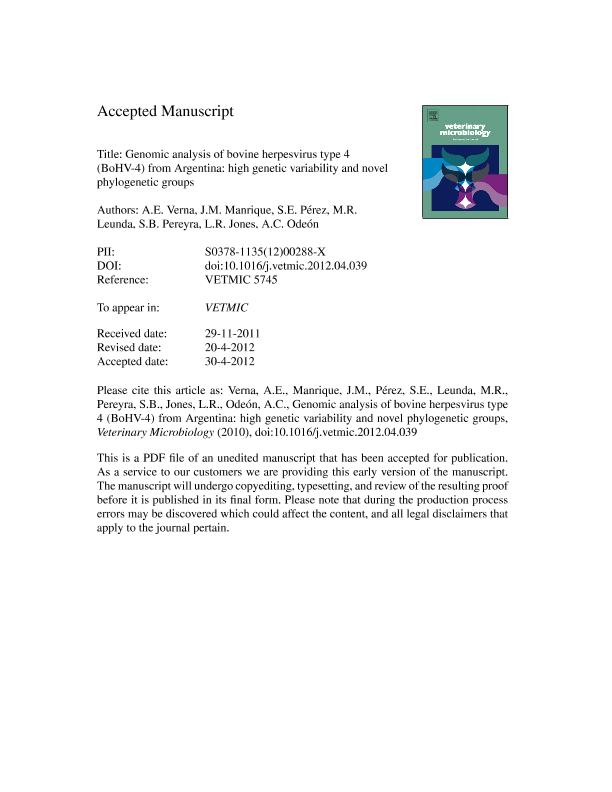Mostrar el registro sencillo del ítem
dc.contributor.author
Verna, Andrea Elizabeth

dc.contributor.author
Manrique, Julieta Marina

dc.contributor.author
Pérez, Sandra Elizabeth
dc.contributor.author
Leunda, M. R.
dc.contributor.author
Pereyra, Susana Beatriz

dc.contributor.author
Jones, Leandro Roberto

dc.contributor.author
Odeón, Anselmo Carlos

dc.date.available
2023-05-29T11:31:40Z
dc.date.issued
2012-11
dc.identifier.citation
Verna, Andrea Elizabeth; Manrique, Julieta Marina; Pérez, Sandra Elizabeth; Leunda, M. R.; Pereyra, Susana Beatriz; et al.; Genomic analysis of bovine herpesvirus type 4 (BoHV-4) from Argentina: High genetic variability and novel phylogenetic groups; Elsevier Science; Veterinary Microbiology; 160; 1-2; 11-2012; 1-8
dc.identifier.issn
0378-1135
dc.identifier.uri
http://hdl.handle.net/11336/198710
dc.description.abstract
Bovine herpesvirus 4 (BoHV-4) is a γ-herpesvirus that has been isolated both from apparently healthy animals and from cattle with a variety of clinical signs, including post-partum endometritis and abortion. BoHV-4 causes either a persistent or a latent infection in cells of the monocyte/macrophage lineage. Two groups of BoVH-4 strains have been defined based on their restriction patterns: the Movar-like strains (European prototype) and the DN 599-like strains (American prototype). The purpose of the present study was to genetically characterize wild type BoHV-4 strains isolated from vaginal discharges of aborted cows in Argentina. The virus was identified by isolation and nested PCR in all vaginal discharge samples from aborted cows, either as a sole agent or in association with other pathogens. Restriction enzyme profiling and phylogenetic analysis demonstrated that there is a high genetic variability among the studied field isolates. The existence of three groups of strains, which were designated as genotypes 1, 2 and 3, is described. Genotypes 1 and 2 possibly correspond to the Movar-like and DN 599-like groups, respectively, whereas Genotype 3 corresponds to a novel group. Two viral strains did not cluster into any of these three groups, indicating that other genotypes could be circulating in Argentina. These results suggest a complex epidemiological background for the Argentinean BoHV-4 strains, probably influenced by independent events of genetic drift. This hypothesis cannot be rejected based on the available data. However, there is no direct evidence supporting this possibility. Thus, it seems speculative to suggest that interspecific jumps are responsible for the observed phylogenetic grouping. On the other hand, our analyses suggest a geographical structure for the observed viral genotypes, since genotypes 1 and 2 included the European (Movar-like) and American (DN599-like) reference strains, respectively. Geographic dispersion is known to be a driver of herpes viruses diversification, and independent evolution in geographical isolated places ensures the emergence of particular mutations in each location due to genetic drift (Compans, 2007; Zong et al., 1999). Therefore, at this point, the genetic drift hypothesis is the one that requires less ad-hoc considerations and thus, to our understanding, is the one that fits to the findings from this study. The involvement of this genetic variability in the detection and pathogenesis of BoHV-4 remains to be investigated.
dc.format
application/pdf
dc.language.iso
eng
dc.publisher
Elsevier Science

dc.rights
info:eu-repo/semantics/openAccess
dc.rights.uri
https://creativecommons.org/licenses/by-nc-sa/2.5/ar/
dc.subject
ABORTED COWS
dc.subject
BOVINE HERPESVIRUS TYPE 4
dc.subject
PHYLOGENETIC ANALYSIS
dc.subject
RESTRICTION ENDONUCLEASE
dc.subject.classification
Ciencias Veterinarias

dc.subject.classification
Ciencias Veterinarias

dc.subject.classification
CIENCIAS AGRÍCOLAS

dc.title
Genomic analysis of bovine herpesvirus type 4 (BoHV-4) from Argentina: High genetic variability and novel phylogenetic groups
dc.type
info:eu-repo/semantics/article
dc.type
info:ar-repo/semantics/artículo
dc.type
info:eu-repo/semantics/publishedVersion
dc.date.updated
2023-05-24T16:54:51Z
dc.journal.volume
160
dc.journal.number
1-2
dc.journal.pagination
1-8
dc.journal.pais
Países Bajos

dc.journal.ciudad
Amsterdam
dc.description.fil
Fil: Verna, Andrea Elizabeth. Instituto Nacional de Tecnología Agropecuaria. Centro Regional Buenos Aires Sur. Estación Experimental Agropecuaria Balcarce. Área de Investigación en Producción y Sanidad Animal; Argentina. Consejo Nacional de Investigaciones Científicas y Técnicas; Argentina
dc.description.fil
Fil: Manrique, Julieta Marina. Consejo Nacional de Investigaciones Científicas y Técnicas; Argentina. Fundación Playa Unión. Estación de Fotobiología Playa Unión; Argentina
dc.description.fil
Fil: Pérez, Sandra Elizabeth. Universidad Nacional del Centro de la Provincia de Buenos Aires; Argentina
dc.description.fil
Fil: Leunda, M. R.. Instituto Nacional de Tecnología Agropecuaria. Centro Regional Buenos Aires Sur. Estación Experimental Agropecuaria Balcarce. Área de Investigación en Producción y Sanidad Animal; Argentina
dc.description.fil
Fil: Pereyra, Susana Beatriz. Instituto Nacional de Tecnología Agropecuaria. Centro Regional Buenos Aires Sur. Estación Experimental Agropecuaria Balcarce. Área de Investigación en Producción y Sanidad Animal; Argentina
dc.description.fil
Fil: Jones, Leandro Roberto. Consejo Nacional de Investigaciones Científicas y Técnicas; Argentina. Fundación Playa Unión. Estación de Fotobiología Playa Unión; Argentina
dc.description.fil
Fil: Odeón, Anselmo Carlos. Instituto Nacional de Tecnología Agropecuaria. Centro Regional Buenos Aires Sur. Estación Experimental Agropecuaria Balcarce. Área de Investigación en Producción y Sanidad Animal; Argentina
dc.journal.title
Veterinary Microbiology

dc.relation.alternativeid
info:eu-repo/semantics/altIdentifier/url/https://www.sciencedirect.com/science/article/pii/S037811351200288X
dc.relation.alternativeid
info:eu-repo/semantics/altIdentifier/doi/http://dx.doi.org/10.1016/j.vetmic.2012.04.039
Archivos asociados
